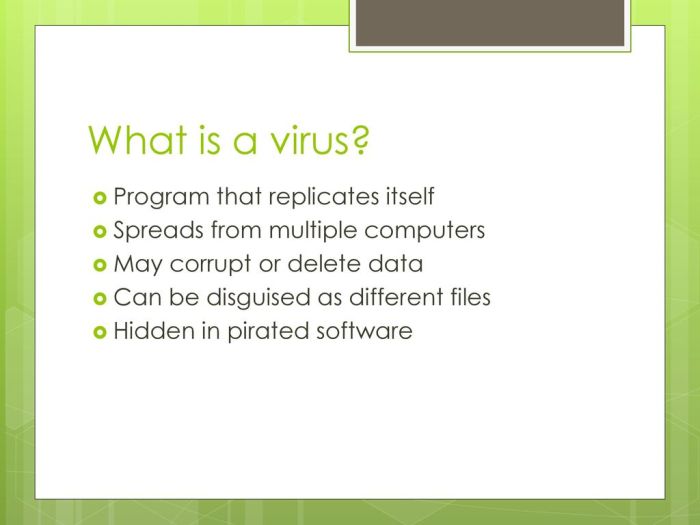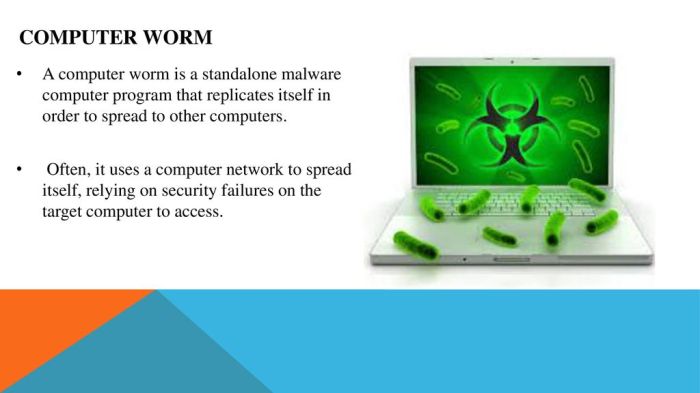A program that replicates itself and clogs computers and networks. – Self-replicating programs, capable of replicating themselves and clogging computers and networks, present a formidable threat to the digital realm. Their ability to spread and infect systems poses significant risks and consequences, making it imperative to delve into the intricacies of these malicious entities.
This comprehensive exploration will shed light on the mechanisms of self-replication in computer programs, examining how they exploit vulnerabilities to propagate and disrupt systems. We will delve into the methods employed by these programs to consume resources and cause widespread damage, drawing upon real-world incidents to illustrate their devastating impact.
Self-Replication in Computer Programs
Self-replication is the ability of a computer program to create copies of itself. This process can occur within a single computer system or across multiple computers connected through a network.
Self-replicating programs are often used for malicious purposes, such as spreading viruses and worms. These programs can spread rapidly, infecting multiple computers and causing significant damage to networks and systems.
Methods of Self-Replication
- File Infection:Self-replicating programs can attach themselves to existing files on a computer system. When the infected file is executed, the program replicates itself and infects other files.
- Boot Sector Infection:Self-replicating programs can infect the boot sector of a computer’s hard drive. This allows the program to load itself into memory every time the computer is started, ensuring its continued presence on the system.
- Network Infection:Self-replicating programs can spread across networks by exploiting vulnerabilities in network protocols or operating systems. These programs can scan for vulnerable systems and send copies of themselves to those systems.
Risks and Consequences
- Data Loss:Self-replicating programs can delete or corrupt data stored on infected systems.
- System Disruption:These programs can consume system resources, such as memory and CPU time, slowing down or even crashing infected systems.
- Network Congestion:Self-replicating programs can clog networks by sending large amounts of data, disrupting communication and causing network outages.
Clogging of Computers and Networks

Self-replicating programs can clog computers and networks by consuming excessive resources and disrupting operations.
Methods of Clogging
- Resource Exhaustion:Self-replicating programs can create multiple copies of themselves, consuming large amounts of memory and CPU time. This can slow down or even crash infected systems.
- Network Flooding:These programs can send large amounts of data across networks, clogging bandwidth and disrupting communication.
- Denial of Service (DoS) Attacks:Self-replicating programs can be used to launch DoS attacks by flooding a target system with so much data that it becomes inaccessible.
Real-World Incidents
- Morris Worm (1988):The Morris Worm was the first major self-replicating worm to infect the Internet. It infected over 6,000 computers, causing significant disruption and economic damage.
- Code Red Worm (2001):The Code Red Worm infected over 250,000 computers in less than 10 hours. It exploited a vulnerability in Microsoft’s Internet Information Server (IIS) web server software.
- MyDoom Worm (2004):The MyDoom Worm was a mass-mailing worm that infected over a million computers. It clogged networks and caused significant disruption.
Detection and Prevention: A Program That Replicates Itself And Clogs Computers And Networks.

Detecting and preventing self-replicating programs can be challenging, as they are designed to avoid detection and bypass security measures.
Detection Techniques
- Signature-Based Detection:Antivirus software uses signatures to identify known self-replicating programs. However, these programs can often evade detection by changing their signatures.
- Heuristic Detection:Heuristic detection methods analyze the behavior of programs to identify suspicious activity that may indicate a self-replicating program.
- Sandbox Analysis:Sandbox analysis involves running programs in a controlled environment to monitor their behavior and identify any malicious activity.
Prevention Techniques
- Software Updates:Keeping software up to date with the latest security patches can help prevent infections from self-replicating programs that exploit vulnerabilities.
- Antivirus Software:Using antivirus software with up-to-date virus definitions can help detect and block self-replicating programs.
- Firewalls:Firewalls can help prevent self-replicating programs from spreading across networks by blocking unauthorized access to systems.
Mitigation and Recovery

Mitigating the effects of a self-replicating program infection and recovering from it requires a systematic approach.
Mitigation Steps
- Isolate Infected Systems:Disconnect infected systems from networks to prevent the spread of the infection.
- Run Antivirus Software:Use antivirus software to scan and remove the self-replicating program.
- Restore from Backups:If the infected system cannot be cleaned, restore it from a backup created before the infection occurred.
Recovery Guidance, A program that replicates itself and clogs computers and networks.
- Data Recovery:Use data recovery tools to recover any data that may have been lost or corrupted during the infection.
- System Hardening:Implement additional security measures to prevent future infections, such as updating software, installing firewalls, and using strong passwords.
- Post-Infection Analysis:Conduct a thorough analysis of the infection to identify the source of the attack and develop strategies to prevent similar incidents in the future.
FAQ Compilation
What are the common methods used by self-replicating programs to clog computers and networks?
Self-replicating programs employ various techniques to clog computers and networks, including consuming excessive CPU and memory resources, flooding networks with traffic, and exploiting vulnerabilities to gain unauthorized access.
How can self-replicating programs be detected and prevented?
Detecting and preventing self-replicating programs requires a combination of antivirus software, intrusion detection systems, and regular software updates. Additionally, implementing strong network security measures and educating users about potential threats can help mitigate the risk of infection.
What are the best practices for recovering from a self-replicating program infection?
Recovering from a self-replicating program infection involves isolating the infected system, running antivirus scans, and restoring data from backups. It is crucial to seek professional assistance if the infection is severe or affects critical systems.